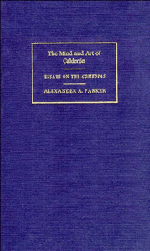Book contents
- Frontmatter
- Contents
- Author's preface
- Editor's preface
- Introduction
- I Stylistic and dramatic craftsmanship
- 1 Principles of interpretation
- 2 From metaphor to symbol
- 3 The dramatic structure of El alcalde de Zalamea
- 4 ‘Poetic truth’ in the shaping of plots
- 5 The Coriolanus theme: Las armas de la hermosura
- II From experience to myth
- III The tensions of social life
- IV The tensions of public life
- V From symbol to myth
- Epilogue
- Notes
- Index
2 - From metaphor to symbol
Published online by Cambridge University Press: 05 February 2012
- Frontmatter
- Contents
- Author's preface
- Editor's preface
- Introduction
- I Stylistic and dramatic craftsmanship
- 1 Principles of interpretation
- 2 From metaphor to symbol
- 3 The dramatic structure of El alcalde de Zalamea
- 4 ‘Poetic truth’ in the shaping of plots
- 5 The Coriolanus theme: Las armas de la hermosura
- II From experience to myth
- III The tensions of social life
- IV The tensions of public life
- V From symbol to myth
- Epilogue
- Notes
- Index
Summary
In the centenary year of 1881 the young Marcelino Menéndez Pelayo brought his course of lectures on Calderón to a close by enumerating the defects of his art. They were: ‘Verbosity, the empty pomp of his diction, attention paid more to intrigues and to the movement on the stage than to the painstaking and careful dissection and analysis of a character.’ Since then, the third centenary of Calderón's death has been celebrated, and a very different picture emerged from most of the commemorative addresses. It has become more usual, in fact, to look for his artistic merits precisely in his ‘language’, in the ‘intrigues’ of his plots, and in the ‘movement on stage’. One aspect of his style and technique which is fundamental for the study of his art forms the subject of this chapter.
A characteristic example of my preoccupation is the relatively early play, La cisma de Ingalaterra, whose metaphors and symbols will be dealt with in general terms here, while the fuller study of its theme and its dramatic significance will be taken up again in a later chapter. The play was performed in the salón de teatro, the small private theatre in the Madrid palace before the Coliseo was constructed. At the beginning of this play, King Henry VIII receives two letters, one from the Pope and one from Luther; he mistakenly throws the Pope's letter at his feet and puts Luther's on his head. Later, Anne Boleyn enters; so arrogant is she that she dislikes kneeling even before the king, but as she approaches him, she stumbles and falls.
- Type
- Chapter
- Information
- The Mind and Art of CalderónEssays on the Comedias, pp. 25 - 41Publisher: Cambridge University PressPrint publication year: 1989



